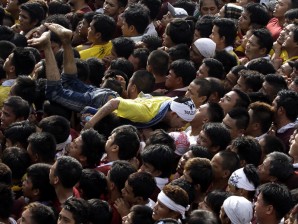
A Filipino devotee dives on the crowd after kissing a wooden image of Jesus Christ, known as the Black Nazarene, as they celebrate the feast day at Manila's Rizal Park Monday, Jan. 9, 2012. Millions of Roman Catholic devotees paraded with the Black Nazarene statue through the Philippine capital under a massive police cordon after Philippine President Benigno Aquino III warned that terrorists might target the raucous annual procession. AP PHOTO/AARON FAVILA
MANILA, Philippines—A human sea of Catholic pilgrims flooded the Philippine capital on Monday in a show of religious frenzy, despite warnings that Islamic militants may be planning to bomb the spectacular annual event.
Police estimated up to eight million people crammed into the historic quarters of Manila seeking to touch the “Black Nazarene,” a centuries-old and life-size icon of Jesus Christ that is believed to hold miraculous powers.
Many among the heaving, roaring crowd risked injury by clambering over others in a bid to make contact with the icon and win its healing favor, while most people traipsed through the dirty streets barefoot as a sign of devotion.
“For as long as I can walk or crawl, I will join the procession. That is my vow,” 47-year-old Ruby Pacardo told AFP after rubbing her grandson’s shirt on the icon to help him overcome cataract problems and regain his full vision.
The turnout, similar to the millions of devotees attracted every year, came after President Benigno Aquino warned on Sunday that authorities had uncovered a plot to attack the event, potentially with a mobile phone-triggered bomb.
Defense Secretary Voltaire Gazmin told reporters on Monday that police were hunting nine people believed to be involved in planning the attacks, and named two well-known Islamic militant groups as possibly being behind the threat.
“This is a target of opportunity, this Feast of Nazarene, so we should be alarmed,” Gazmin told reporters.
He said a huge police presence was on show for the procession, which was expected to last well into the night, while mobile phone coverage had been blocked close to the icon in a bid to thwart any remote-triggered bomb.
Gazmin said the suspects were from the southern Philippines, a hotbed of Islamic militancy, and that security forces believed they may belong to the Al-Qaeda-linked Abu Sayyaf or the Moro Islamic Liberation Front (MILF).
The Abu Sayyaf is a band of just a few hundred militants but is blamed for the country’s worst attacks, including the bombing of a ferry in Manila Bay in 2004 in which more than 100 people died.
The MILF has about 12,000 armed followers and has been waging a separatist rebellion in the southern Philippines since the 1960s that has claimed tens of thousands of lives.
Its leaders are currently involved in peace talks with the government and have disavowed terrorism, but they have previously acknowledged an inability to control “rogue” members.
The procession stretched into the night as the statue was transported across clogged Manila roads, and police said there had been no terrorist-related incidents.
The Red Cross, however, said nearly 300 devotees suffered various injuries, including dehydration, bruises and cuts and high blood pressure.
“There were no reports of any incidents, but we are still maintaining high police visibility,” national police chief Nicanor Bartolome said.
Manila warehouseman Maximo Graciano, 44, a Black Nazarene procession participant for the past 15 years, told AFP as he jostled among the crowd that the terrorism warning was not enough to keep him away.
“If we allow ourselves to be cowed by terrorism, it means we do not really believe in Him,” said Graciano, who insisted the icon had helped him regain the full use of his right arm after it was severely injured in a car accident.
At least 80 percent of the Philippines’ population of 94 million are Catholic, a legacy of the country’s Spanish colonial past, while about four percent are Muslim.
Most of the Philippines’ Islamic minority live in the south, a fertile and resource-rich area that remains impoverished partly because of the violence that plagues the area.
Defense Secretary Gazmin said authorities had been aware of plans to attack the Black Nazarene festival as far back as August last year.
He also revealed security forces raided three “safehouses” allegedly used by the suspects last week but that nobody had been captured.